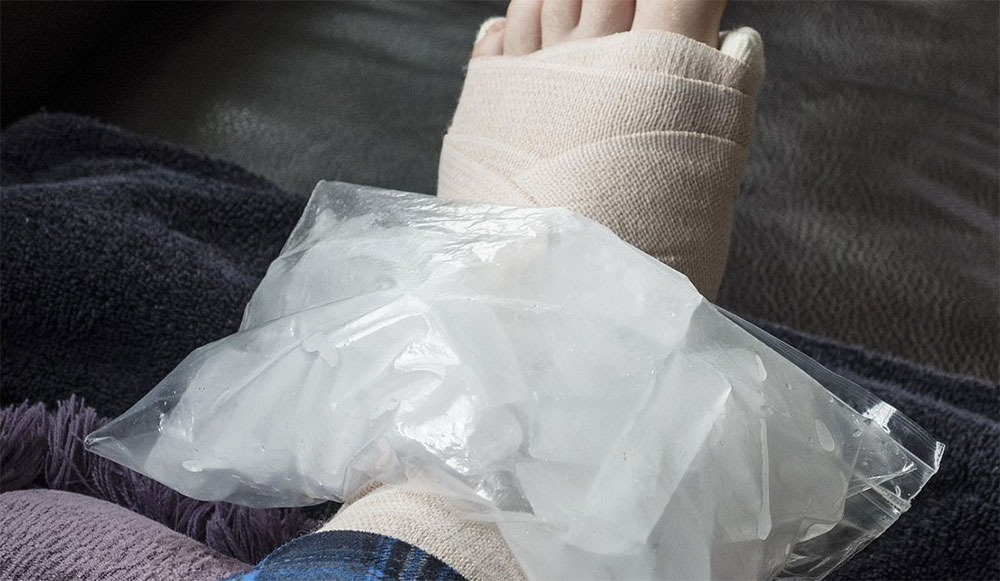A cooling pack for the sore shin, the heat pad for the tense neck: do these methods really help – and what happens in the body? Experts provide answers.
Whether you have a bruised arm or a cracked foot: The PECH scheme should be used for injuries of this type. “It stands for: break, ice, compression, elevation,” explains sports medicine specialist Axel Klein.
For example, after a painful kick on the shin while playing football: Ideally, you should put your shin up, put on a tight bandage, put on a cool pack and fix it with a light bandage, describes the Vice President of the German Society for Sports Medicine and Prevention.
Cold reduces swelling and pain
Swelling occurs because small blood vessels are damaged. The cold causes the vessels to contract and close more quickly. The transmission of pain signals to the brain is also inhibited by cooling. So it doesn’t hurt so much anymore.
The orthopaedic surgeon and trauma surgeon Thomas Gottfried recommends using coolants for all acute injuries, including bruises or fractures – but never for open injuries.
How to prevent frostbite
However, caution is required when using it. In the worst case, if you don’t pay attention, your skin will freeze. “There are two cold reactions that you can feel,” says Gottfried. First of all, there is the first cold pain, which is completely normal and no reason to interrupt. “Then there is a habituation effect and the second cold pain follows. You have to be careful and interrupt the supply of cold to prevent frostbite,” says the specialist from the German Society for Orthopedics and Orthopedic Surgery. This second cold pain is a signal that body temperature is dropping, and that could lead to dangerous areas.
If you move in the area of cold casts or cold wraps, there is normally no danger, says Gottfried. For coolants such as ice packs or ice granules, the temperature of which is around freezing point, he recommends using them for 30 minutes at a time and then taking a break. “When it comes to frozen ice compresses, you should definitely put a terry towel on the skin so that it doesn’t damage the skin. You should cool here for about 15 to 20 minutes.”
Cool for two days, then it’s over
A quite harmless variant: “You can rub an ice cube over the area again and again,” advises Axel Klein. The body is not exposed to permanent cooling, but it always has an analgesic effect.
Klein recommends cooling an injured area for a maximum of two days. “By the third day at the latest, you want to stimulate your metabolism again so that the tissue is supplied with blood as well as possible,” he explains. Too much cold is a hindrance.
Under these conditions, coolants can easily be used at home without medical assistance. However, there are exceptions: “One should be careful with certain clinical pictures, for example with circulatory disorders or sensitivity to cold,” says Thomas Gottfried. The same applies to forms of sensitivity disturbance because the warning mechanisms are disabled: “Those affected often do not feel the cold pain.”
Warmth opens the vessels
The use of heat, for example in the form of cherry stone pillows, hot water bottles or red light lamps, can alleviate symptoms – but not in the case of acute injuries.
“Warmth has the effect of making the tissue softer,” explains Gottfried. That helps with overload syndromes, for example with severe muscle soreness. “Heat is also suitable for tissue sticking or scarring – it can be helpful for all connective tissue changes.”
Warmth opens the vessels and makes them widen, thus improving blood circulation in the body. Heat also has an analgesic effect. “That is why warming agents are also often used, for example, for menstrual pain or chronic inflammation,” says Gottfried.
Red spots and pain are warning signs
If the heat causes red spots on the skin, it is generally not dangerous. It is a problem when there is also pain. Then there may well be a first-degree burn, says the expert. It is reversible, i.e. it heals without permanent damage, but still: pain in combination with redness should always be viewed as a warning signal.
Axel Klein advises that you always listen to your own feelings when using heat. “It should be pleasantly warm,” says the specialist in orthopaedics and sports medicine. A lot helps a lot, which is the wrong motto in this case. A heating pad or a red light lamp should be used several times a day rather than once for a long time.
“Caution is advised with fresh infections,” says Thomas Gottfried. “Heat can be too stressful for the body.”

